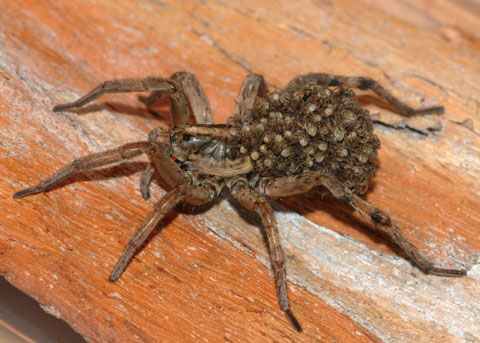Adaptation
The Schizocosa mccooki is the only wolf spider that can
tolerate abiotic conditions and survive in meadows (Suttle,
2003). The S. mccooki shows an uncommon trait related
to other wolf spiders in the area in that it has a higher
tolerance to different temperatures and aridity (Sharp, 2013).
The S. mccooki has adapted to the temperature
fluctuations in the colder months by developing a sort of
hibernated state. Near the end of summer the S. mccooki
dig burrows where they den up for the long winter months ahead,
but they don’t actually hibernate. They instead become torpid,
or inactive (Merriam-Webster, 2013). They only come
out of their dens on the warmest winter days only to possibly get food, otherwise they remain completely inactive
throughout the winter. In these burrows crafted by the S.
mccooki, the walls are varnished with a thin layer of silk
to act as an insuluator during these winter months (Suttle,
2003). Another strange function of the S. mccooki
and all wolf spiders have that no other spider species seems to
have is that after their young hatch, the offspring all crawl on
to their mothers back and she carries them for about a week
(Sharp, 2013). The mother S. mccooki carries the
offspring in order to protect them until they have matured
enough to go out on their own. A unique adaptation that is
expressed by the S. mccooki can be seen while forging
for food. In an instance when the S. mccooki is out
matched by the competitor, the wolf spider will willingly trade
an appendage in exchange for preserving a life. Now hindered by
the loss of a limb, the S. mccooki can only survive for
so long. In most situations that the wolf spider will face in
the future, the success rate will be hindered due to the
handicap of shortage of a single limb or multiples.The S. mccooki wolf spider kills its prey
in an interesting way. It uses its long legs to grab the prey,
then using its mouth it holds and crushes the prey, while the
fangs inject venom to kill it and actually begin the process of
indigestion (Sharp, 2013). But one thing about the wolf spider is that it does
not always kill just to eat, it seems that at times the wolf
spider may kill just to kill (Sharp, 2013). There is some evidence that this
helps keep down various insect populations, but there is no
evidence why the spiders do it. One last adaptation is how the males
attract the females. They drum themselves with their legs to show their interest
in the female. The beats differ from spider to spider, the
successful male drumming will result in the pronouncement of a
mate (Sharp, 2013). Thus allowing the
reproduction process to
begin.
possibly get food, otherwise they remain completely inactive
throughout the winter. In these burrows crafted by the S.
mccooki, the walls are varnished with a thin layer of silk
to act as an insuluator during these winter months (Suttle,
2003). Another strange function of the S. mccooki
and all wolf spiders have that no other spider species seems to
have is that after their young hatch, the offspring all crawl on
to their mothers back and she carries them for about a week
(Sharp, 2013). The mother S. mccooki carries the
offspring in order to protect them until they have matured
enough to go out on their own. A unique adaptation that is
expressed by the S. mccooki can be seen while forging
for food. In an instance when the S. mccooki is out
matched by the competitor, the wolf spider will willingly trade
an appendage in exchange for preserving a life. Now hindered by
the loss of a limb, the S. mccooki can only survive for
so long. In most situations that the wolf spider will face in
the future, the success rate will be hindered due to the
handicap of shortage of a single limb or multiples.The S. mccooki wolf spider kills its prey
in an interesting way. It uses its long legs to grab the prey,
then using its mouth it holds and crushes the prey, while the
fangs inject venom to kill it and actually begin the process of
indigestion (Sharp, 2013). But one thing about the wolf spider is that it does
not always kill just to eat, it seems that at times the wolf
spider may kill just to kill (Sharp, 2013). There is some evidence that this
helps keep down various insect populations, but there is no
evidence why the spiders do it. One last adaptation is how the males
attract the females. They drum themselves with their legs to show their interest
in the female. The beats differ from spider to spider, the
successful male drumming will result in the pronouncement of a
mate (Sharp, 2013). Thus allowing the
reproduction process to
begin.
To learn more about Nutrition click HERE